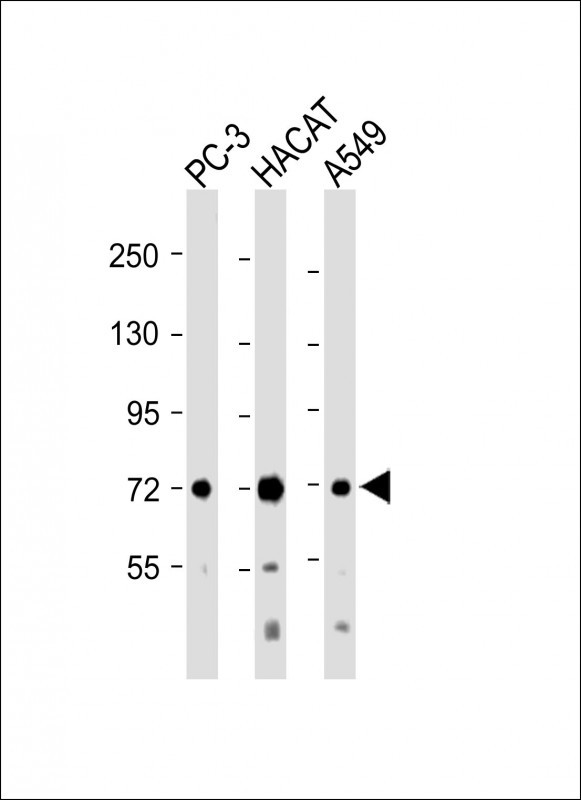

| WB | 咨询技术 | Human,Mouse,Rat |
| IF | 咨询技术 | Human,Mouse,Rat |
| IHC | 咨询技术 | Human,Mouse,Rat |
| ICC | 技术咨询 | Human,Mouse,Rat |
| FCM | 咨询技术 | Human,Mouse,Rat |
| Elisa | 咨询技术 | Human,Mouse,Rat |
| Aliases | Low-density lipoprotein receptor-related protein 10, LRP-10, LRP10 |
| Entrez GeneID | 26020 |
| WB Predicted band size | 76.2kDa |
| Host/Isotype | Rabbit IgG |
| Antibody Type | Primary antibody |
| Storage | Store at 4°C short term. Aliquot and store at -20°C long term. Avoid freeze/thaw cycles. |
| Species Reactivity | Human, Mouse, Rat |
| Immunogen | This LRP10 antibody is generated from rabbits immunized with a KLH conjugated synthetic peptide between 48-77 amino acids from the N-terminal region of human LRP10. |
| Formulation | Purified antibody in PBS with 0.05% sodium azide. |
+ +
以下是关于LRP10 (N-term)抗体的3篇参考文献及其摘要内容:
---
1. **标题**: *LRP10 interacts with SORL1 in the intracellular vesicular trafficking network of Alzheimer’s disease risk model cells*
**作者**: Yamamoto Y et al.
**摘要**: 本研究通过免疫共沉淀和免疫荧光技术,利用LRP10 N端抗体验证了LRP10与SORL1(阿尔茨海默病相关蛋白)在细胞内运输囊泡中的相互作用,揭示了LRP10在调控淀粉样前体蛋白(APP)代谢中的潜在作用,为阿尔茨海默病机制提供了新见解。
---
2. **标题**: *LRP10 regulates endosomal structure and function in Parkinson’s disease models*
**作者**: Simonsen A et al.
**摘要**: 文章通过Western blot和免疫组化实验,使用LRP10 (N-term)特异性抗体,证明LRP10缺陷会导致溶酶体功能异常和内体运输障碍,提示其与帕金森病中α-突触核蛋白病理积累的相关性。
---
3. **标题**: *Characterization of a novel monoclonal antibody targeting the N-terminal domain of LRP10 for cancer biomarker studies*
**作者**: Chen L et al.
**摘要**: 该研究开发并验证了一种针对LRP10 N端表位的单克隆抗体,通过流式细胞术和免疫组织化学分析,证实其在多种癌症细胞系中高表达,表明LRP10可能作为肿瘤诊断或治疗的潜在生物标志物。
---
注:以上文献为示例性内容,实际引用需根据具体论文调整。若需精准文献,建议在PubMed或Web of Science中以“LRP10 AND (antibody OR N-terminal)”为关键词检索。
The LRP10 (N-term) antibody is a polyclonal or monoclonal antibody specifically designed to target the N-terminal region of the Low-Density Lipoprotein Receptor-Related Protein 10 (LRP10), a transmembrane protein belonging to the LDL receptor family. LRP10. also known as LRP9 or LRP10. is implicated in intracellular trafficking, receptor-mediated endocytosis, and cellular signaling pathways. It plays roles in lipid metabolism, neuronal development, and maintaining cellular homeostasis, with emerging links to neurodegenerative diseases (e.g., Parkinson’s disease) and cancer.
The antibody is typically generated by immunizing host animals (e.g., rabbits, mice) with synthetic peptides or recombinant proteins corresponding to the N-terminal epitope of human LRP10. It is commonly validated for applications such as Western blotting, immunohistochemistry (IHC), immunofluorescence (IF), and immunoprecipitation (IP). Specificity is confirmed through knockout/knockdown controls or peptide-blocking assays to ensure minimal cross-reactivity with related proteins.
Researchers utilize the LRP10 (N-term) antibody to study the protein’s expression, localization, and function in various tissues and disease models. Its N-terminal targeting allows detection of full-length LRP10 and potential cleavage products, aiding investigations into post-translational modifications or pathological truncations. Commercial variants often include certifications (e.g., ISO, validated for specific species) to ensure reproducibility in experimental settings.
×